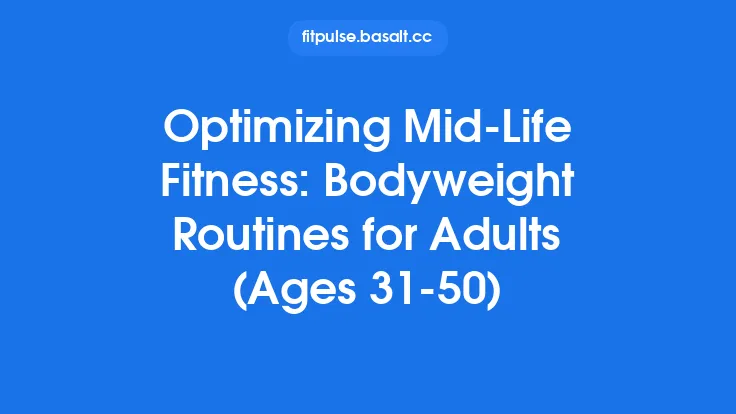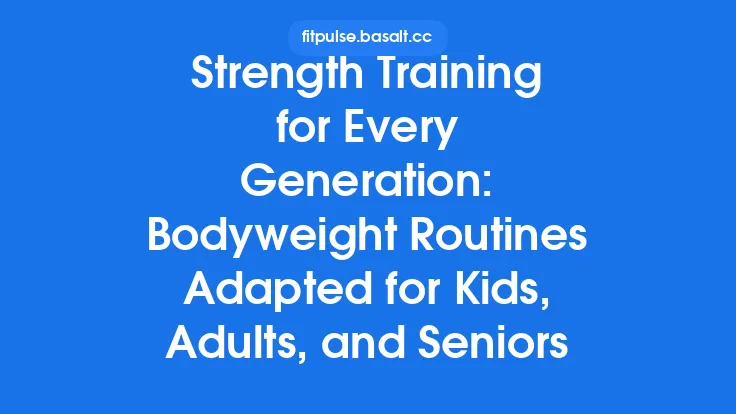Bodyweight training is uniquely suited to the 18‑30 age bracket because it leverages the natural hormonal milieu, high recovery capacity, and the desire for functional strength that many young adults seek. In this phase of life, the body is primed for rapid adaptations, making it an ideal window to establish movement patterns, strength foundations, and conditioning habits that will serve well into later decades. By focusing on mastery of fundamental bodyweight movements, progressive overload, and balanced programming, young adults can build a resilient musculoskeletal system, improve cardiovascular health, and cultivate a lifelong fitness mindset without the need for extensive equipment or gym memberships.
Understanding the Young Adult Physiology
Hormonal Landscape
- Testosterone and Growth Hormone: Both peak in the late teens and early twenties, facilitating muscle protein synthesis and neuromuscular adaptations.
- Insulin Sensitivity: Higher than in older cohorts, allowing efficient glycogen replenishment and nutrient uptake after training.
Musculoskeletal Characteristics
- Joint Mobility: Generally greater range of motion, especially in the shoulders, hips, and ankles, which supports deeper squat and push‑up variations.
- Tendon Stiffness: Optimal balance between elasticity and stiffness, enabling rapid force transmission during explosive movements.
Neurological Factors
- Motor Unit Recruitment: Faster recruitment and firing rates, which translate to quicker strength gains when training with high‑intensity bodyweight drills.
- Learning Plasticity: The central nervous system is highly adaptable, making it easier to acquire complex movement patterns such as handstand balances or pistol squats.
Key Principles of Effective Bodyweight Training
- Progressive Overload
- Increase difficulty by manipulating variables: leverage (e.g., elevating feet), tempo (slow eccentrics), volume (more sets/reps), or adding external load (weighted vest).
- Movement Quality Over Quantity
- Prioritize full range of motion, controlled tempo, and proper alignment to develop joint stability and prevent compensatory patterns.
- Balanced Development
- Address push, pull, hinge, squat, core, and anti‑extension/rotation movements to avoid muscular imbalances that can lead to injury later.
- Specificity and Transferability
- Choose exercises that mimic daily activities or sport-specific demands, ensuring the strength gained is functional and applicable.
- Recovery Integration
- Leverage the natural recovery advantage of this age group by scheduling adequate rest, sleep, and active recovery sessions.
Essential Exercise Movements
| Category | Core Exercise | Primary Muscles | Progression Options |
|---|---|---|---|
| Push | Standard Push‑Up | Pectoralis, deltoids, triceps | Incline/decline, archer push‑up, one‑arm push‑up |
| Pull | Inverted Row (under a sturdy bar) | Latissimus, rhomboids, biceps | Feet elevated, weighted vest, single‑arm row |
| Squat | Bodyweight Squat | Quadriceps, glutes, hamstrings | Bulgarian split squat, pistol squat, jump squat |
| Hinge | Glute Bridge | Glutes, hamstrings, lower back | Single‑leg bridge, hip thrust, weighted bridge |
| Core | Plank Variations | Rectus abdominis, transverse abdominis, obliques | Side plank, plank with shoulder taps, dynamic plank walks |
| Anti‑Extension | Hollow Hold | Core stabilizers | Hollow rock, weighted hollow hold |
| Anti‑Rotation | Pallof Press (using a resistance band) | Obliques, deep core | Increase band tension, single‑leg stance |
Building a Balanced Routine
- Frequency
- 3–5 sessions per week, alternating focus areas (e.g., push/pull on separate days or full‑body sessions).
- Structure
- Warm‑up (5‑10 min): Dynamic mobility (leg swings, arm circles), joint activation (scapular retractions, glute bridges).
- Skill/Strength Block (20‑30 min): Primary movement patterns with progressive overload.
- Conditioning Block (10‑15 min): Metabolic work (e.g., EMOMs, interval circuits) to support cardiovascular health.
- Cool‑down (5‑10 min): Static stretching, breathing exercises, foam rolling if needed.
- Volume & Intensity
- Strength Focus: 3–5 sets of 4–8 reps at high difficulty (e.g., decline push‑ups).
- Hypertrophy/Endurance Focus: 2–4 sets of 12–20 reps with moderate difficulty (e.g., standard squats).
- Periodization
- Macrocycle (12 weeks): Divide into 3 mesocycles—foundational (weeks 1‑4), strength‑building (weeks 5‑8), and performance/peak (weeks 9‑12).
- Microcycle (weekly): Adjust volume/intensity to allow deloads (e.g., a lighter “recovery” day every 7th day).
Progression Strategies Within the 18‑30 Window
- Linear Progression: Add a rep or two each session until the target rep range is reached, then increase difficulty.
- Undulating Progression: Vary rep ranges and difficulty across the week (e.g., heavy day, moderate day, light day) to stimulate multiple adaptation pathways.
- Skill‑Based Progression: For complex moves (handstand, muscle‑up), break the skill into components (wall‑supported handstand, tuck handstand, full handstand) and allocate dedicated practice time.
- Load‑Based Progression: Introduce external weight (5‑10 kg vest) once bodyweight variations become too easy, ensuring the load does not compromise form.
- Tempo Manipulation: Slow eccentric phases (3‑5 seconds) to increase time‑under‑tension without adding external load.
Mobility and Flexibility Considerations
Even though young adults typically enjoy good mobility, targeted work prevents the development of restrictive patterns that can limit progression:
- Shoulder Mobility: Band dislocates, wall slides, and thoracic extensions to support deeper push‑up variations and handstand work.
- Hip Flexor & Hamstring Flexibility: Dynamic lunges, pigeon stretch, and standing hamstring floss to maintain squat depth.
- Ankle Dorsiflexion: Calf raises, wall ankle mobilizations, and barefoot walking to improve squat mechanics and jump performance.
Incorporate mobility drills at the end of each session or as a dedicated 10‑minute routine on rest days.
Recovery and Lifestyle Factors
- Sleep: Aim for 7‑9 hours of quality sleep; growth hormone peaks during deep sleep, crucial for muscle repair.
- Nutrition Basics: Sufficient protein (1.6‑2.2 g/kg body weight), balanced carbohydrates for glycogen replenishment, and healthy fats for hormone production.
- Hydration: Maintain urine color light yellow; dehydration can impair strength and cognitive performance.
- Active Recovery: Light activities such as brisk walking, swimming, or yoga promote circulation without taxing the nervous system.
- Stress Management: Chronic cortisol elevation can blunt anabolic signaling; incorporate mindfulness, hobbies, or social interaction to keep stress in check.
Tracking Progress and Setting Goals
- Objective Metrics
- Reps/Set Max: Record the highest rep count for each core movement.
- Skill Milestones: Document progressions (e.g., “able to hold a wall handstand for 30 seconds”).
- Performance Tests: Periodic assessments like the 3‑minute burpee test, max push‑up test, or vertical jump height.
- Subjective Measures
- Perceived Exertion (RPE): Use a 1‑10 scale to gauge session difficulty.
- Energy Levels & Mood: Track daily logs to identify overtraining signs.
- Goal Framework
- SMART Goals: Specific, Measurable, Achievable, Relevant, Time‑bound (e.g., “Increase pistol squat depth to parallel within 8 weeks”).
- Periodized Goal Setting: Align short‑term goals with mesocycle focus (strength, endurance, skill).
Transitioning to Advanced Calisthenics
Once foundational strength and mobility are solid, young adults can explore more demanding calisthenic disciplines:
- Planche Progressions: Start with frog stand → tuck planche → advanced tuck → straddle planche.
- Front/Back Lever Work: Use support bands, progress to negative levers, then full holds.
- One‑Arm Pull‑Ups: Begin with assisted variations (band, weighted backpack) before attempting strict reps.
Key to successful transition is maintaining a strong base: continue to train fundamental movements, incorporate specific strength‑to‑skill drills, and avoid sacrificing joint health for novelty.
Common Mistakes and How to Avoid Them
| Mistake | Why It’s Problematic | Corrective Action |
|---|---|---|
| Skipping Warm‑up | Increases injury risk, reduces performance | Allocate 5‑10 min to dynamic mobility each session |
| Relying Solely on Reps | Neglects intensity; plateaus quickly | Use difficulty variations, tempo, or added load |
| Neglecting Pull Movements | Leads to rounded shoulders, weak back | Include at least one pulling exercise per session |
| Overtraining Frequency | Diminishes recovery, hampers gains | Schedule 1‑2 rest or active‑recovery days per week |
| Poor Form for Aesthetic “Progressions” | Builds bad motor patterns, joint stress | Prioritize technique; use video feedback or a coach |
| Ignoring Core Stability | Limits transfer to complex skills | Integrate anti‑extension/rotation core work regularly |
Putting It All Together: Sample Weekly Plan
| Day | Focus | Main Sets | Conditioning | Mobility/Recovery |
|---|---|---|---|---|
| Monday | Upper‑Body Push/Pull | 4 × 8 × Decline Push‑Ups, 4 × 8 × Inverted Rows (feet elevated) | EMOM 5 min: 10 × Burpees | Shoulder band dislocates, thoracic extensions |
| Tuesday | Lower‑Body & Core | 4 × 10 × Bulgarian Split Squats, 3 × 12 × Glute Bridges, 3 × 30 s × Hollow Holds | 3‑Round AMRAP 4 min: 15 × Air Squats, 10 × Mountain Climbers | Hip flexor stretch, ankle dorsiflexion drills |
| Wednesday | Active Recovery | Light jog or swim (30 min) | – | Full‑body foam roll, yoga flow (15 min) |
| Thursday | Push‑Heavy + Skill | 5 × 5 × Archer Push‑Ups, 3 × 5 × Tuck Handstand Holds | 4 × 30 s × High‑Knees (rest 30 s) | Wrist mobility, scapular wall slides |
| Friday | Pull‑Heavy + Core | 4 × 6 × Weighted Inverted Rows, 3 × 12 × Pallof Press (each side) | 5‑minute Tabata: 20 s × Jump Squats / 10 s × Rest | Lat stretch, thoracic rotation |
| Saturday | Full‑Body Circuit | 3 × Circuit (10 × Push‑Ups, 12 × Squats, 8 × Pull‑Ups, 30 s Plank) | 10 min steady‑state bike | Full‑body dynamic stretch |
| Sunday | Rest | – | – | Sleep hygiene focus, light walking |
Adjust volume/intensity based on individual recovery capacity and goals.
By adhering to these principles—leveraging the physiological advantages of the 18‑30 age range, emphasizing balanced movement patterns, and systematically progressing difficulty—young adults can construct a robust bodyweight foundation. This foundation not only yields immediate gains in strength, endurance, and skill but also embeds habits that protect joint health, support metabolic wellness, and enable seamless transition to more advanced calisthenic pursuits throughout life.





